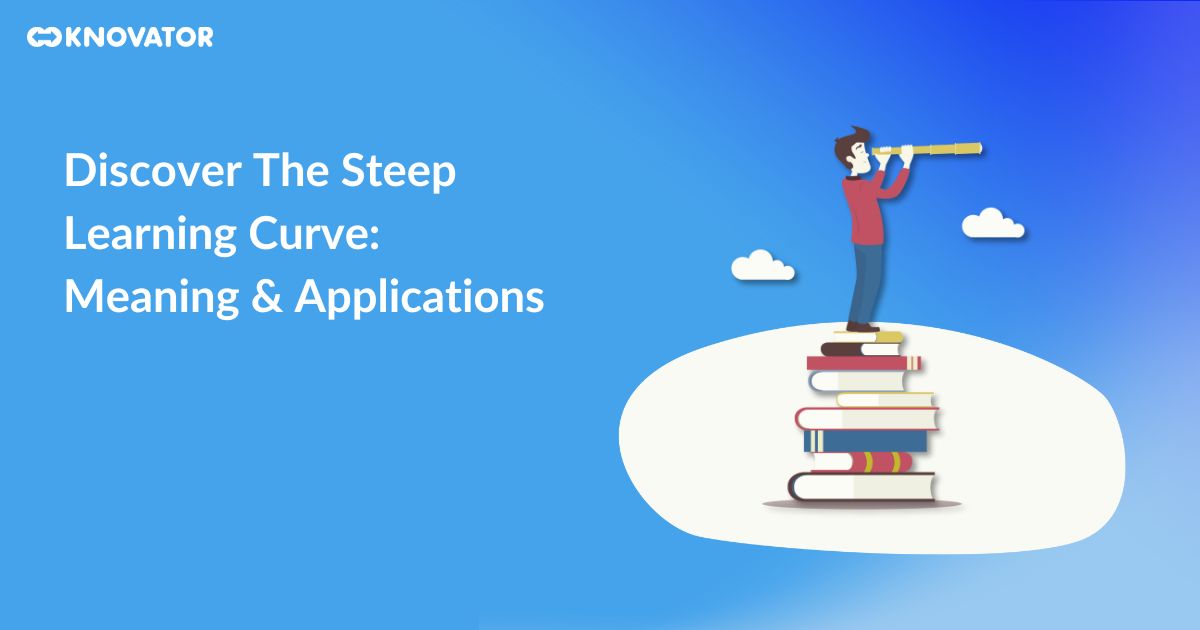Growing and improving your knowledge and skills is like caring for a garden. It takes time and effort. Bloom’s Taxonomy is an educational framework that helps improve learning. It starts with understanding basic ideas and moving on to solving complex problems.
You are in the right place if you are new to this framework.
In this blog post, we’ll explore everything about Bloom’s Taxonomy together with its importance & applications.
So, let’s begin!
What is Bloom’s Taxonomy?
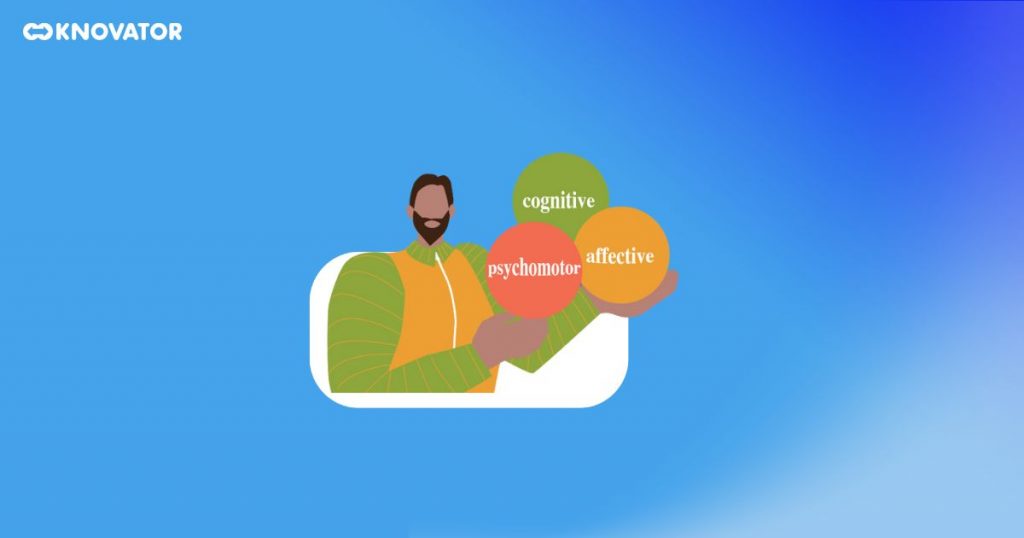
There are six levels in order from lower to higher.
At the foundation level, students can recall facts and information. In the beginning, students can remember things without understanding them.
As they get better at stuff, they show what they know by explaining things in their way. It focuses on the application of knowledge to real-world scenarios. They analyze the data, draw conclusions, and make inferences based on evidence. This level involves critical thinking and judgment. Learners assess and make decisions based on criteria and standards. The highest level of Bloom’s Taxonomy involves originality and creativity.
This approach promotes critical thinking. It also promotes problem-solving and higher-order thinking skills among students. It helps students solve problems by making their learning experience better.
Educators use Bloom’s Taxonomy to classify different stages of learning. This framework helps them to set clear and organized learning objectives. Bloom’s Taxonomy helps teachers set specific goals. It can help them measure the progress of their students.
Original Bloom’s Taxonomy
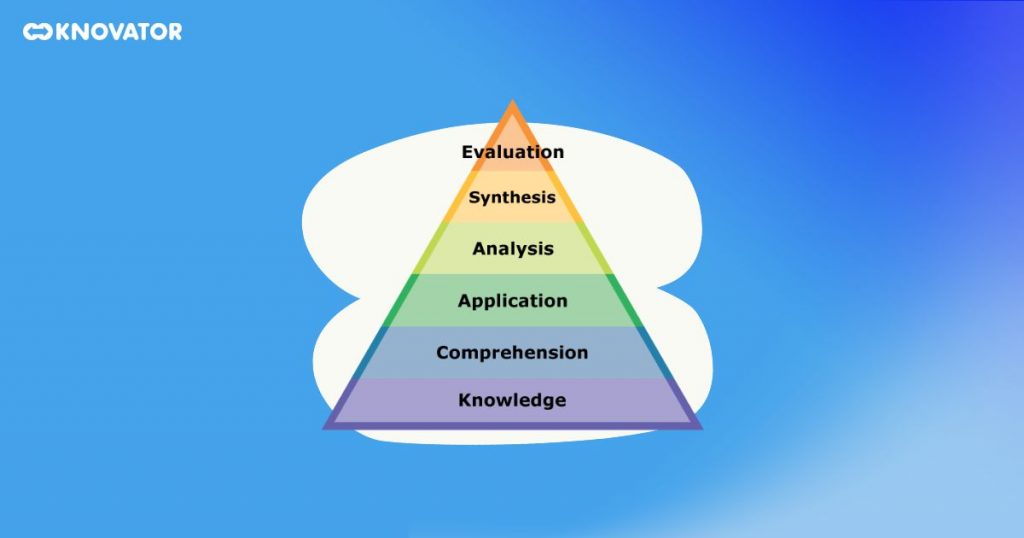
- Knowledge: The basic learning level involves recalling facts or information.
- Comprehension: The next level where learners understand the meaning of the material and can explain or restate it.
- Application: The use of learned material in new and concrete situations.
- Analysis: The breaking down of complex information into parts to understand its structure or organization.
- Synthesis: The ability to combine parts to form a new whole or propose alternative solutions.
- Evaluation: The highest level of cognitive learning involves making judgments or forming opinions about the value and worth of an idea, a solution, or a piece of work based on a set of criteria.
The impact of Bloom’s Taxonomy on education has been significant. Bloom’s Taxonomy changed how teachers teach and test students. Students learn how to think critically, solve problems, and be creative. It helps students learn better. Teachers set goals for what students should learn and teach them differently. Bloom’s Taxonomy also helps teachers test students in a better way. So they can see if students understand and can use what they learned. Bloom’s Taxonomy improves education by helping students think more and learn more.
Revised Bloom’s Taxonomy

One significant change in the Revised Bloom’s Taxonomy is that each category is now described by a verb rather than a noun, indicating the active learning process. Additionally, the categories were reorganized and relabeled:
- Remembering (previously Knowledge): Recalling or retrieving previously learned information.
- Understanding (previously Comprehension): Constructing meaning from different types of functions, whether they are written or graphic messages or activities.
- Applying (unchanged): Using a concept in a new context.
- Analyzing (previously Analysis): Separating material into parts and determining how they relate to one another and an overall structure or purpose.
- Evaluating (previously Synthesis): Making judgments based on criteria and standards.
- Creating (previously Evaluation): Putting parts together to form a functional whole; reorganizing elements into a new pattern or structure.
The Revised Bloom’s Taxonomy also introduced a second dimension, the Knowledge Dimension, which describes the knowledge to be learned: Factual, Conceptual, Procedural, and Metacognitive. This allows educators to better align teaching and assessment techniques with clearly mentioned learning objectives.
The Revised Bloom’s Taxonomy remains a highly effective tool for educators to plan and evaluate learning objectives, making it a fundamental resource in education.
Bloom’s Taxonomy Levels
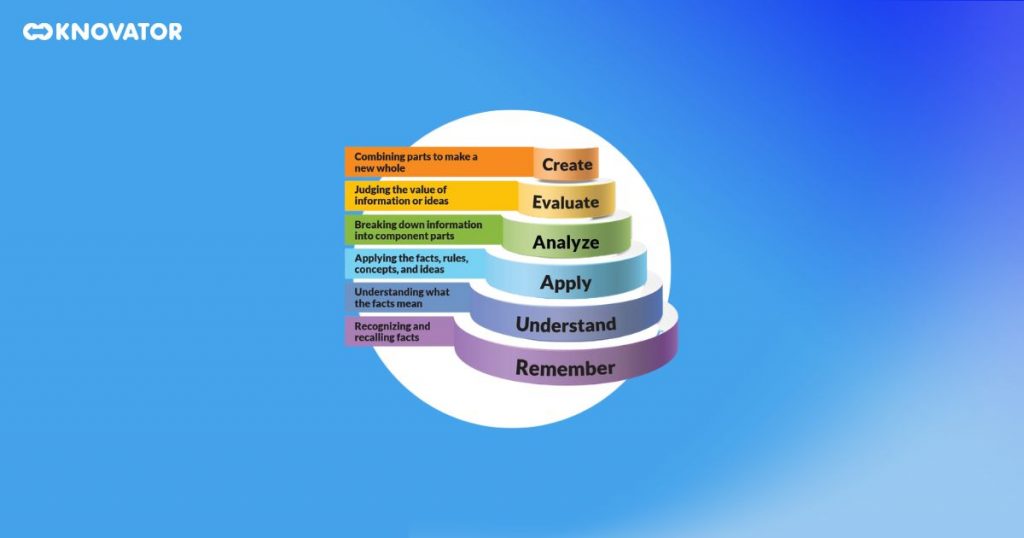
- Remembering: This is the most basic level of the hierarchy. Learners are expected to retrieve or recall previously learned information at this stage. The cognitive activities associated with this level may include reciting a fact, term, concept or answering straightforward questions about specific details. Activities include listing, naming, identifying, and recalling basic information or facts.
- Understanding: Here, learners must demonstrate comprehension of the information or ideas. This could mean explaining an idea in their own words, summarizing a concept, or interpreting a diagram. It’s about making sense of the information beyond memorizing, including tasks like classifying, summarizing, illustrating, and explaining.
- Applying: This level requires learners to use the information in new ways or apply it in a different context. For instance, students might use a theory they have learned to solve a problem, implement a procedure in a practical scenario, or apply a concept to a real-world situation. Tasks involve implementing, executing, or using information in real-world scenarios.
- Analyzing: At this stage, learners must break information into parts and explore relationships and organizational structures. This might involve recognizing patterns, identifying components, understanding outcomes, or determining how parts relate to one another. It’s about dissecting information to understand its structure, which includes differentiating, organizing, and relating.
- Evaluating: The second-highest level of Bloom’s Taxonomy requires learners to judge the value of ideas or materials. This could involve critiquing an argument, judging the relevance of a source, or defending a particular viewpoint. Here, students critique, judge, and defend the value of material against set criteria.
- Creating: The top level of the hierarchy involves generating new ideas, products, or ways of viewing things. This might involve designing a new machine, planning a research study, or formulating a new program. Learners can design, construct, plan, or produce something new, synthesizing previously learned material in creative and original ways.
Importance of Bloom’s Taxonomy
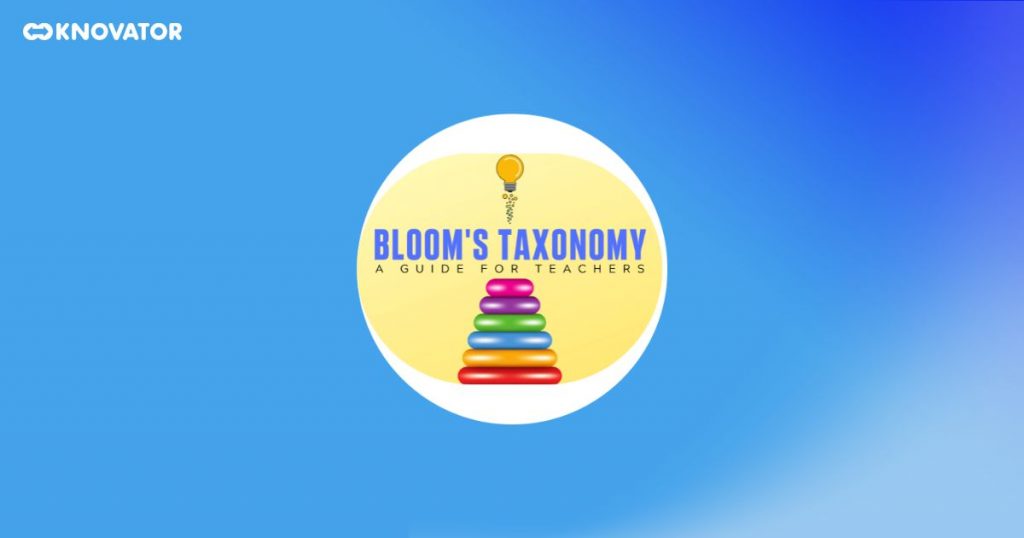
- Helps Plan Lessons: Bloom’s Taxonomy helps teachers plan their lessons better. It makes it easy to decide what to teach and when to teach it. It helps to arrange topics from simple to complex, which makes learning easier for students.
- Guides Teaching Methods: The taxonomy helps teachers pick the best teaching methods. For example, reading or lectures can teach simple tasks like remembering facts. Students might need to do projects or group work for more complex tasks like problem-solving.
- Helps Make Tests: Teachers can use Bloom’s Taxonomy to make tests that really check if students have understood the lessons. This way, the tests match what was taught and can accurately measure how well students are learning.
- Encourages Critical Thinking: Bloom’s Taxonomy goes beyond just remembering facts. It encourages students to analyze information, solve problems, and think creatively. This helps students to become lifelong learners.
- Supports Different Learning Needs: Not all students learn in the same way. Some students might need more help, while others might need more challenging tasks. Bloom’s Taxonomy helps teachers to meet these different needs.
- Improves Communication: Bloom’s Taxonomy gives teachers a common language to talk about teaching and learning. It helps teachers to be clear about what students should learn, how they will be tested, and how they are doing.
So, Bloom’s Taxonomy is really useful. It helps teachers plan lessons, teach effectively, and make good tests. It also helps students to think critically and supports different learning needs. Overall, it makes teaching and learning a lot clearer and more effective.
Bloom’s Taxonomy Verbs
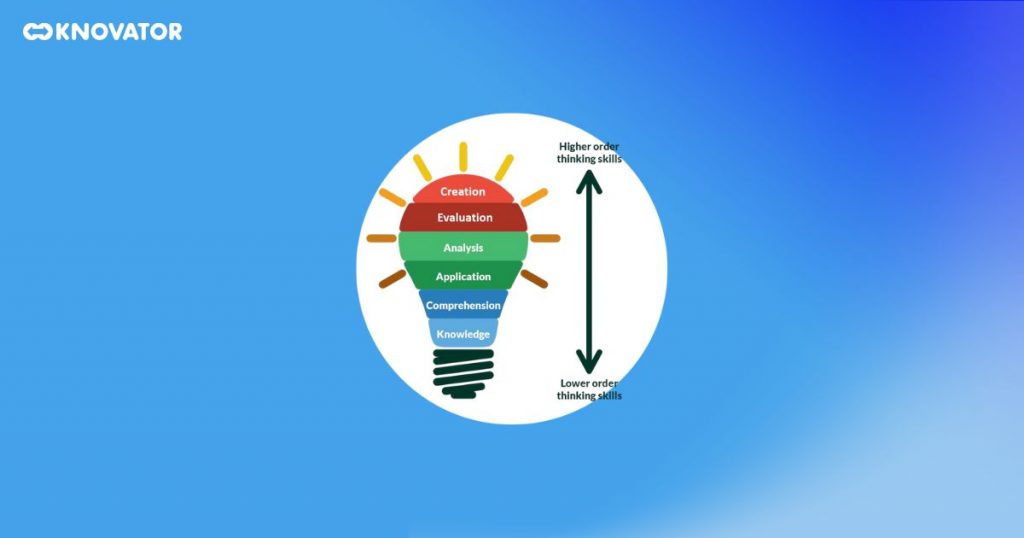
Let’s take a brief look at the types of verbs associated with each level:
- Remembering: This level involves the recall of information. Verbs used include list, define, recall, identify, describe, recognize, and remember.
- Understanding: At this stage, students should be able to explain concepts in their own words. Verbs include explain, summarize, interpret, paraphrase, classify, compare, and discuss.
- Applying: Here, students use the information in new ways. Verbs used at this level include apply, demonstrate, use, illustrate, solve, examine, and classify.
- Analyzing: At this level, students should be able to break down complex concepts into parts. Verbs include analyze, distinguish, differentiate, compare, contrast, investigate, and infer.
- Evaluating: Here, students assess the value of ideas or materials. Verbs used at this level include evaluate, critique, assess, judge, defend, argue, and justify.
- Creating: The highest level involves creating new ideas or products. Verbs used at this level include create, design, formulate, construct, invent, devise, and plan.
Educators can create clear and measurable learning objectives that cater to each cognitive level by choosing the appropriate Bloom’s Taxonomy verbs. These verbs guide both instruction and assessment, ensuring a comprehensive and effective learning process.
Application of Bloom’s Taxonomy
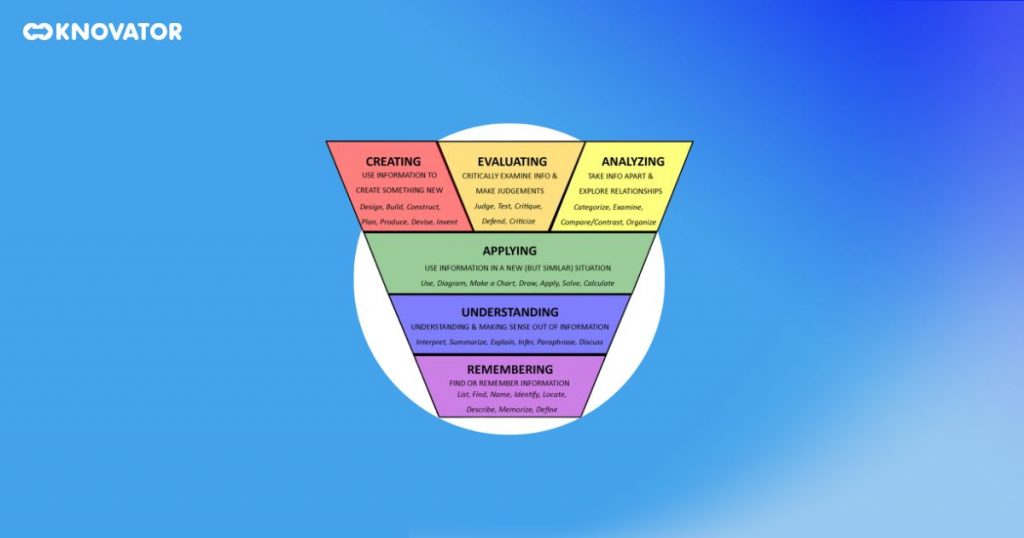
- Lesson Planning: Teachers can use the taxonomy to plan their lessons around clear, measurable learning objectives. By identifying each objective’s cognitive level, teachers can sequence their lessons from simpler to more complex concepts, promoting a natural progression of understanding.
- Instructional Design: Bloom’s Taxonomy guides the instructional methods best suited to each cognitive level. Direct instruction might facilitate lower-level tasks, while higher-level tasks might necessitate collaborative learning or project-based methods.
- Assessment Development: The taxonomy is crucial in devising assessments that accurately measure learning. Test items can be designed to target each level of cognition, ensuring a comprehensive evaluation of student learning. This alignment of instruction, objectives, and assessments enhances the overall teaching and learning process.
- Student Self-Evaluation: Students can also use Bloom’s Taxonomy to measure their own learning. They can identify their cognitive level and what they need to do to reach higher levels, which helps with self-awareness and self-directed learning.
- Professional Development: The taxonomy is also instrumental in professional development. Educators can use it to improve their teaching strategies and curriculum development skills. The shared language of the taxonomy enables communication about teaching and learning in professional learning communities.
- Integration of Technology: With the rise of digital learning, Bloom’s Taxonomy has been adapted to incorporate technology. The “Digital Bloom’s Taxonomy” incorporates digital actions and tools at each cognitive level, helping educators integrate technology into instruction effectively.
Let’s Sum Up Bloom’s Taxonomy
Educators can enhance teaching and learning using Bloom’s Taxonomy. It categorizes cognitive skills into six levels. This approach promotes gradual learning. It cultivates critical thinking and improves problem-solving capabilities. It helps to equip students with the skills they need to succeed in the real world.
Bloom’s Taxonomy enhances teaching and learning experiences. It encourages progressive learning from basic understanding to higher-order thinking and improves creativity. Bloom’s Taxonomy applies in real-world educational settings. It empowers teachers to design effective lesson plans and promotes active student engagement.
Overall, Bloom’s Taxonomy is a powerful and versatile framework for educators and learners.








